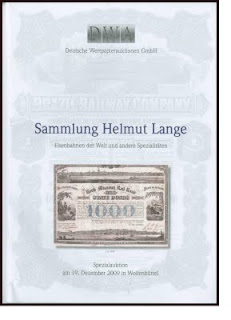
I update my online database twice per month. Before uploading the database, I run a series of “cleanup" procedures. One cleanup step makes sure I display the most current record-high and record-low prices.
Only a few new record-high prices have appeared in recent years. In fact, there has been a steady procession of record-low or near-record-low prices ever since I started recording eBay sales.
My last database update was December 1 and the situation was different. This time, the numbers of new record-low and new record-high prices were nearly identical.
At first, you might think dealers would applaud this unforeseen uptick in prices. But not so fast!
On closer examination, I noticed that all new record-high prices occurred in Germany and almost all new record-low prices occurred in the U.S. Not meaning to sound alarmist, this is not a good trend for either American collectors or dealers.
Heavy selling by amateurs on eBay continues to depress prices in the U.S. EBay has effectively trained collectors to expect bargain basement low prices, even for scarce and rarely-seen certificates. Yet even with online auction prices at fifteen- and twenty-year lows, 50% to 60% of eBay certificates still go unsold. Never mind that prices are at levels that would have been considered insane a few years ago.
If we look to Europe, we see the Euro trading at a 50% premium to the dollar. Combine the weak dollar with eBay-induced low prices and European collectors have no choice but to view American certificates as
dirt cheap.
At the end of November, FHW (Freunde Historischer Wertpapiere) offered 70 North American railroad certificates in its large auction #96 in Berlin. FHW's minimum starting bids are very high by American standards. Nonetheless, collectors bought 47% of North American railroad certificates offered. Some of those lots sold at prices that would scare the Hell out of most American collectors. After accounting for commission, value added taxes and the dollar-Euro conversion penalty, lots sold for 100% to 500% (!!!) of my estimated catalog prices!
(An example of the Wildwood & Delaware Bay Short Line Railroad certificate shown above sold for $50 on eBay in May. The certificate shown just sold for $258 in Berlin.)
American certificates fetched significant prices in Europe throughout 2009. Even if high prices can be blamed on the weak dollar, the disparity
SHOULD be a wake-up call to American collectors. It is obvious that significant numbers of non-American collectors genuinely appreciate rarity and are willing to pay for it. If the dollar continues to weaken and if American collectors continue to ignore rarity, they will wake up some day in the future to find many rare American certificates gone.
Price disparities for collectibles will always exist. Prices always depend on where, when and how collectibles are sold. It is completely normal to see 2X price disparities in our hobby; 3X disparities are not uncommon. The price disparities we're currently seeing, though, are abnormal and 5X price differences are unlikely to linger. Nonetheless, the fact that there are such huge differences of opinion in regard to prices should concern hobbyists on both sides.
Regardless of where they live, collectors can argue that European prices are too high or that American prices are too low. They can argue that European collectors over-value rarity and second-tier autographs. They can argue that American collectors don't value rarity at all. They can argue any way they want.
They can even argue that the one inviolable law of collecting does not apply to them.
But they will be wrong.
Simply put, collectibles
always move toward money.
 The latest full-color issue of Scripophily arrived a couple days ago. (See my announcement about the August issue for more information on supporting the International Bond and Share Society.) As before, I ask you to join me in supporting this organization which is now almost 42 years old.
The latest full-color issue of Scripophily arrived a couple days ago. (See my announcement about the August issue for more information on supporting the International Bond and Share Society.) As before, I ask you to join me in supporting this organization which is now almost 42 years old.

